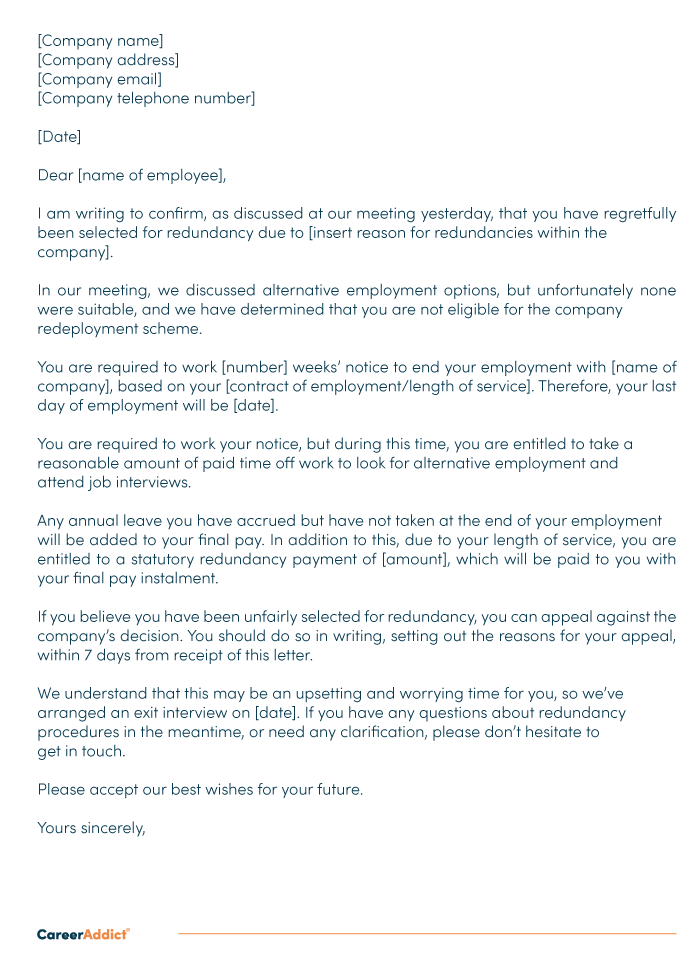Examining the Interplay In Between Company Redundancy and Business Adaptability for Future Development
In the dynamic landscape these days's service globe, the detailed connection in between business redundancy and business versatility becomes a vital element for continual growth and success. Business frequently encounter the challenge of striking a fragile equilibrium between keeping a level of redundancy to alleviate risks and promoting flexibility to respond quickly to the ever-evolving market demands. This delicate interaction holds the key to not only enduring in rough times yet also prospering in the face of uncertainty. As we discover the multifaceted dimensions of this interaction, fascinating insights into just how companies navigate these complexities to lead the means for future growth await.
Relevance of Business Redundancy
Business redundancy is a crucial element that enhances business resilience and alleviates functional dangers. By including redundancy actions within the business structure, business can much better stand up to unanticipated disturbances and variations in the organization setting. Redundancy works as a calculated buffer, enabling companies to adapt and react properly to unforeseen difficulties without jeopardizing important operations.
One key facet of the relevance of business redundancy is its function in guaranteeing connection throughout times of dilemma. When confronted with sudden adjustments or emergency situations, redundant systems, sources, or employees can action in to maintain critical features and avoid widespread disturbances. This connection not only safeguards the firm's reputation and consumer depend on but additionally lessens financial losses and functional downtime.

Approaches for Organizational Adaptability

An additional crucial technique is purchasing modern technology and infrastructure that can support flexibility and scalability. Carrying out electronic devices, automation, and information analytics can simplify procedures, improve efficiency, and provide important insights for notified decision-making. Additionally, producing versatile business frameworks that enable quick modifications to market dynamics and client requirements is necessary for remaining affordable in a quickly progressing setting. By proactively determining prospective interruptions and chances, organizations can proactively thrive and adjust in an ever-changing organization landscape.
Balancing Redundancy and Adaptability
Attaining a harmonious equilibrium in between operational redundancy and business versatility is critical in browsing the intricacies of a dynamic organization atmosphere. Redundancy within a company gives a security net, making certain continuity and security in operations. However, an extra of redundancy can lead to inadequacies and hinder flexibility to altering market problems. On the other hand, business adaptability permits firms to react promptly to exterior disruptions and confiscate new possibilities. Striking the right equilibrium in between redundancy and versatility is a fragile process that needs a deep understanding of the company's goals, sector dynamics, and danger resistance.
To accomplish this equilibrium, companies need to conduct routine evaluations of their operations to determine areas where redundancy is needed for danger reduction and where versatility can drive advancement and development. Carrying out versatile frameworks, promoting a culture of continuous knowing and improvement, and encouraging open interaction throughout all degrees of the company are essential techniques to harmonize redundancy and adaptability effectively. By straightening these 2 important aspects, business can position themselves for lasting development and success in an ever-changing service landscape.
Situation Studies on Adjustment Success
In checking out circumstances of successful organizational adjustment, it ends up being apparent that the interplay in between operational redundancy and adaptability is a specifying aspect in shaping resistant services. One compelling study is that of Netflix. At first a DVD rental solution, Netflix showed amazing flexibility by transitioning right into a streaming platform great post to read when digitalization interfered with the market. By tactically purchasing innovation and content production, Netflix not only prospered however endured in a quickly evolving market. One more standout example is Amazon. Starting as an on-line bookstore, Amazon continually adapted its organization model, increasing into varied sectors such as cloud computing and expert system. This adaptability allowed Amazon to remain ahead of rivals and satisfy changing customer demands. Finally, Adobe gives a noteworthy picture of effective adaptation. The business changed from selling software application licenses to a subscription-based version, guaranteeing persisting revenue streams and improved client involvement. These study emphasize the significance of operational redundancy combined with business flexibility in fostering long-term growth and competition.
Building Resilience for Future Development
Structure resilience for future development needs a calculated positioning of functional processes with market characteristics and arising trends. Firms should adjust to altering settings by promoting a society of versatility, innovation, and continual improvement.
In addition, fostering solid relationships with stakeholders, such as consumers, employees, distributors, and the community, is crucial for weathering uncertainties and keeping trust and assistance throughout rough times. Reliable communication and transparency play an essential role in building strength, as they help line up assumptions and facilitate collaboration in browsing unpredictabilities.
Furthermore, organizations require to focus on learning and development efforts to upskill staff members and outfit them with the required tools to adjust to transforming conditions. By investing in their workforce, business can improve their flexibility and dexterity, ultimately strengthening their durability for sustainable future growth.
Final Thought

In the dynamic landscape of today's company globe, the intricate connection in between company redundancy and business flexibility emerges as a critical element for continual development and success. Companies commonly face the difficulty of striking a fragile equilibrium between preserving a degree of redundancy to mitigate risks and promoting flexibility to respond swiftly to the ever-evolving market needs.To attain this equilibrium, companies need to carry out normal assessments of their operations to determine locations where redundancy is essential for risk mitigation and where versatility can drive technology and growth.In verdict, the interaction in between company redundancy and organizational versatility is vital for future development. Structure strength through a combination of redundancy and adaptability will guarantee that business are prepared for the difficulties of the future.